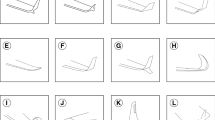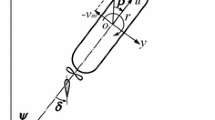Abstract
The joint clearance of rudder loop has a significant impact in achieving the high-precision attitude control of aircraft. This study proposed a novel revolute joint clearance contact model considering surface topography. Such a model identified that the impact dynamic characteristics were significantly influenced by parameters such as contact speed, roughness, and curvature radius of asperities. The dynamic model of the rudder loop was based on the Lagrange equation and the contact model of revolute joint clearance. The results indicated that rudder angle error, contact force, and impact frequency nonlinearly increased along with the increase of motor speed. The increment of joint clearance caused increased rudder angle error and contact force, but a decreased impact frequency. An increase in contact surface roughness decreased the contact force and exerted insignificant effects on rudder angle and impact frequency. To verify the dynamic model, a dynamic characteristic test rig of rudder loop was established. This study can improve the dynamic analysis accuracy of the rudder loop with clearance and provide a solid theoretical basis for solving the high-precision control of the discontinuous structure.













Similar content being viewed by others
Data availability
Enquiries about data availability should be directed to the authors.
References
Flores, P.: A parametric study on the dynamic response of planar multibody systems with multiple clearance joints. Nonlinear Dyn. 61, 633–653 (2010). https://doi.org/10.1007/s11071-010-9676-8
Gummer, A., Sauer, B.: Modeling planar slider-crank mechanisms with clearance joints in RecurDyn. Multibody Syst. Dyn. 31, 127–145 (2014). https://doi.org/10.1007/s11044-012-9339-2
Tsai, M.J., Lai, T.H.: Accuracy analysis of a multi-loop linkage with joint clearances. Mech. Mach. Theory 43, 1141–1157 (2008). https://doi.org/10.1016/j.mechmachtheory.2007.09.001
Erkaya, S., Uzmay, I.: Optimization of transmission angle for slider-crank mechanism with joint clearances. Struct. Multidiscip. Optim. 37, 493–508 (2009). https://doi.org/10.1007/s00158-008-0243-6
Mach, M.: Dynamic response of a revolute joint with clearance. Mech. Mach. Theory. 3, 121–134 (1996)
Gonthier, Y., McPhee, J., Lange, C., Piedbœuf, J.C.: A regularized contact model with asymmetric damping and dwell-time dependent friction. Multibody Syst. Dyn. 11, 209–233 (2004). https://doi.org/10.1023/B:MUBO.0000029392.21648.bc
Erkaya, S.: Clearance-induced vibration responses of mechanical systems: computational and experimental investigations. J. Brazilian Soc. Mech. Sci. Eng. (2018). https://doi.org/10.1007/s40430-018-1015-x
Lankarani, H.M., Nikravesh, P.E.: Continuous contact force models for impact analysis in multibody systems. Nonlinear Dyn. 5, 193–207 (1994). https://doi.org/10.1007/BF00045676
Flores, P.: Modeling and simulation of wear in revolute clearance joints in multibody systems. Mech. Mach. Theory 44, 1211–1222 (2009). https://doi.org/10.1016/j.mechmachtheory.2008.08.003
Yuan, H., Wang, H., Li, S., Dai, J.S.: Revelation of metamorphic phenomenon through the equivalent mechanisms and development of the novel metamorphic epicyclic gear trains. Mech. Mach. Theory 166, 104433 (2021). https://doi.org/10.1016/j.mechmachtheory.2021.104433
Wang, R., Sun, J., Dai, J.S.: Design analysis and type synthesis of a petal-inspired space deployable-foldable mechanism. Mech. Mach. Theory 141, 151–170 (2019). https://doi.org/10.1016/j.mechmachtheory.2019.07.005
Tian, Q., Flores, P., Lankarani, H.M.: A comprehensive survey of the analytical, numerical and experimental methodologies for dynamics of multibody mechanical systems with clearance or imperfect joints. Mech. Mach. Theory 122, 1–57 (2018). https://doi.org/10.1016/j.mechmachtheory.2017.12.002
Marques, F., Isaac, F., Dourado, N., Flores, P.: An enhanced formulation to model spatial revolute joints with radial and axial clearances. Mech. Mach. Theory 116, 123–144 (2017). https://doi.org/10.1016/j.mechmachtheory.2017.05.020
Cavalieri, F.J., Cardona, A.: Non-smooth model of a frictionless and dry three-dimensional revolute joint with clearance for multibody system dynamics. Mech. Mach. Theory 121, 335–354 (2018). https://doi.org/10.1016/j.mechmachtheory.2017.09.018
Koshy, C.S., Flores, P., Lankarani, H.M.: Study of the effect of contact force model on the dynamic response of mechanical systems with dry clearance joints: Computational and experimental approaches. Nonlinear Dyn. 73, 325–338 (2013). https://doi.org/10.1007/s11071-013-0787-x
Li, Y., Wang, C., Huang, W.: Dynamics analysis of planar rigid-flexible coupling deployable solar array system with multiple revolute clearance joints. Mech. Syst. Signal Process. 117, 188–209 (2019). https://doi.org/10.1016/j.ymssp.2018.07.037
Muvengei, O., Kihiu, J., Ikua, B.: Dynamic analysis of planar rigid-body mechanical systems with two-clearance revolute joints. Nonlinear Dyn. 73, 259–273 (2013). https://doi.org/10.1007/s11071-013-0782-2
Erkaya, S., Uzmay, I.: Experimental investigation of joint clearance effects on the dynamics of a slider-crank mechanism. Multibody Syst. Dyn. 24, 81–102 (2010). https://doi.org/10.1007/s11044-010-9192-0
Skrinjar, L., Slavič, J., Boltežar, M.: A validated model for a pin-slot clearance joint. Nonlinear Dyn. 88, 131–143 (2017). https://doi.org/10.1007/s11071-016-3234-y
Khemili, I., Romdhane, L.: Dynamic analysis of a flexible slider-crank mechanism with clearance. Eur. J. Mech. A/Solids. 27, 882–898 (2008). https://doi.org/10.1016/j.euromechsol.2007.12.004
Greenwood, J.A., Williamson, J.B.P.: Contact of nominally flat surfaces. Proc. R. Soc. London. Ser. A. Math. Phys. Sci. 295, 300–319 (1966). https://doi.org/10.1098/rspa.1966.0242
Kogut, L., Etsion, I.: A finite element based elastic-plastic model for the contact of rough surfaces. Tribol. Trans. 46, 383–390 (2003). https://doi.org/10.1080/10402000308982641
Andersson, S., Söderberg, A., Olofsson, U.: A random wear model for the interaction between a rough and a smooth surface. Wear 264, 763–769 (2008). https://doi.org/10.1016/j.wear.2006.12.075
Stickel, D., Wimmer, M.A., Fischer, A.: Analyzing pin-on-ball wear tests by means of the Greenwood–Williamson contact model. Wear 301, 4–10 (2013). https://doi.org/10.1016/j.wear.2012.12.056
Kadin, Y., Kligerman, Y., Etsion, I.: Unloading an elastic-plastic contact of rough surfaces. J. Mech. Phys. Solids 54, 2652–2674 (2006). https://doi.org/10.1016/j.jmps.2006.04.013
Jackson, R.L., Green, I.: A statistical model of elasto-plastic asperity contact between rough surfaces. Tribol. Int. 39, 906–914 (2006). https://doi.org/10.1016/j.triboint.2005.09.001
Jin, F., Zhang, W., Wan, Q., Guo, X.: Adhesive contact of a power-law graded elastic half-space with a randomly rough rigid surface. Int. J. Solids Struct. 81, 244–249 (2016). https://doi.org/10.1016/j.ijsolstr.2015.12.001
Greenwood, J.A.: The contact of two nominally flat rough surfaces. Engineering 185, 625–633 (1970)
Ciavarella, M., Delfine, V., Demelio, G.: A “re-vitalized” Greenwood and Williamson model of elastic contact between fractal surfaces. J. Mech. Phys. Solids 54, 2569–2591 (2006). https://doi.org/10.1016/j.jmps.2006.05.006
Whitehouse, D.J.: The properties of random surfaces of significance in their contact. Proc. R. Soc. London. A. Math. Phys. Sci. 316, 97–121 (1970). https://doi.org/10.1098/rspa.1970.0068
Pullen, J., Williamson, J.B.P.: On the plastic contact of rough surfaces. Proc. R. Soc. London. A. Math. Phys. Sci. 327, 159–173 (1972). https://doi.org/10.1098/rspa.1972.0038
Chang, W.R., Bogy, I., Etsion, I.: An elastic-plastic model for the contact of rough surfaces., 109, 257–263 (1986)
Liu, Z., Neville, A., Reuben, R.L.: An analytical solution for elastic and elastic-plastic contact models. Tribol. Trans. 43, 627–634 (2000). https://doi.org/10.1080/10402000008982387
Hunt, K.H., Crossley, F.R.E.: Coefficient of Restitution Interpreted As Damping in Vibroimpact. Am. Soc. Mech. Eng. 42, 440–445 (1975)
Flores, P., MacHado, M., Silva, M.T., Martins, J.M.: On the continuous contact force models for soft materials in multibody dynamics. Multibody Syst. Dyn. 25, 357–375 (2011). https://doi.org/10.1007/s11044-010-9237-4
Song, Z., Gao, D., Zhao, Y., Dai, J.S.: An improved bouc-wen model based on equitorque discretization for a load-dependent nonlinear stiffness actuator. IEEE Trans. Autom. Sci. Eng. 18, 840–849 (2021). https://doi.org/10.1109/TASE.2020.2993277
Acknowledgements
The authors would like to acknowledge the financial support from National Natural Science Foundation of China (No. 52205110) and STU Scientific Research Foundation for Talents (grant numbers NTF20014). The authors would also like to thank Dr. Shitong Peng and Pro. Fengtao Wang for the language editing. The authors would like to thank the anonymous reviewers for their insightful comments and suggestions on an earlier draft of this paper.
Funding
The authors have not disclosed any funding.
Author information
Authors and Affiliations
Corresponding author
Ethics declarations
Conflict of interest
The authors have not disclosed any competing interests.
Additional information
Publisher's Note
Springer Nature remains neutral with regard to jurisdictional claims in published maps and institutional affiliations.
Rights and permissions
Springer Nature or its licensor (e.g. a society or other partner) holds exclusive rights to this article under a publishing agreement with the author(s) or other rightsholder(s); author self-archiving of the accepted manuscript version of this article is solely governed by the terms of such publishing agreement and applicable law.
About this article
Cite this article
Guo, J., Wang, Y., Zhang, X. et al. Dynamic characteristic of rudder loop with rough revolute joint clearance. Nonlinear Dyn 112, 3179–3194 (2024). https://doi.org/10.1007/s11071-023-09131-0
Received:
Accepted:
Published:
Issue Date:
DOI: https://doi.org/10.1007/s11071-023-09131-0




